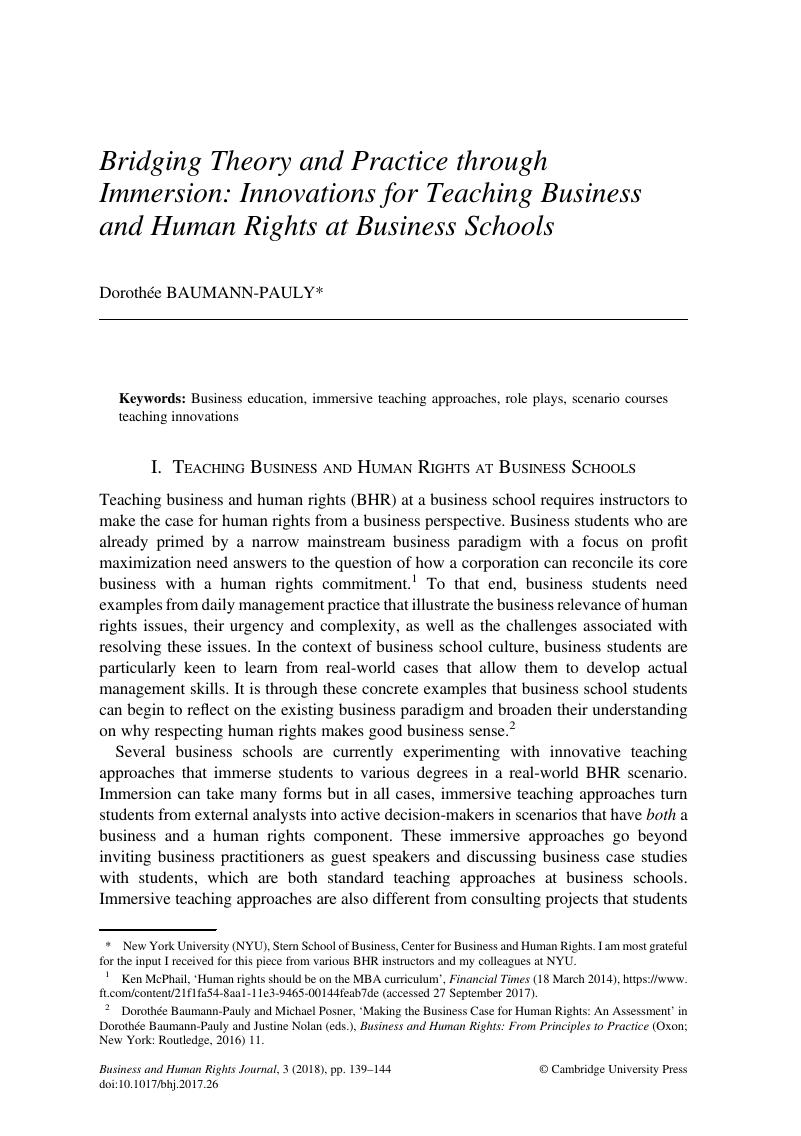Article contents
Bridging Theory and Practice through Immersion: Innovations for Teaching Business and Human Rights at Business Schools
Published online by Cambridge University Press: 23 November 2017
Abstract

Keywords
- Type
- Developments in the Field
- Information
- Copyright
- Copyright © Cambridge University Press
Footnotes
New York University (NYU), Stern School of Business, Center for Business and Human Rights. I am most grateful for the input I received for this piece from various BHR instructors and my colleagues at NYU.
References
1 Ken McPhail, ‘Human rights should be on the MBA curriculum’, Financial Times (18 March 2014), https://www.ft.com/content/21f1fa54-8aa1-11e3-9465-00144feab7de (accessed 27 September 2017).
2 Baumann-Pauly, Dorothée and Posner, Michael, ‘Making the Business Case for Human Rights: An Assessment’ in Dorothée Baumann-Pauly and Justine Nolan (eds.), Business and Human Rights: From Principles to Practice (Oxon; New York: Routledge, 2016) 11 Google Scholar.
3 Bauer, Joanne, ‘Equipping Professionals for the Next Challenges: The Design and Results of a Multidisciplinary Business and Human Rights Clinic’ (2017) 2:2 Business and Human Rights Journal 359 CrossRefGoogle Scholar.
4 Nicholson, Carolyn Y and DeMoss, Michelle, ‘Teaching Ethics and Social Responsibility: An Evaluation of Undergraduate Business Education at the Discipline Level’ (2009) 84:4 Journal of Education for Business 213 CrossRefGoogle Scholar.
5 Hammerley, Hector, ‘The Immersion Approach: Litmus Test of Second Language Acquisition through Classroom Communication’ (2011) 71:4 The Modern Language Journal 395 CrossRefGoogle Scholar.
6 Nicholson and DeMoss, note 4; Strohmetz, David B and Skleder, Anne A, ‘The Use of Role-Play in Teaching Research Ethics: A Validation Study’ (2016) 19:2 Teaching of Psychology 106 CrossRefGoogle Scholar.
7 The instructor, Michael Posner, provided unpublished course material to the author for the purpose of writing this article.
8 The author interviewed the instructors of the class, Florian Wettstein and Ron Popper, to gain insights into their teaching that go beyond the published course outline.
9 University of St Gallen, ‘Course and Examination Fact Sheet: Spring Semester 2017’, http://tools.unisg.ch/Handlers/public/CourseInformationSheet.ashx?Semester=FS17&EventNumber=8,619,1.00 (accessed 27 September 2017).
10 Fair Labor Association, ‘Workplace Code of Conduct’, http://www.fairlabor.org/sites/default/files/fla_code_of_conduct.pdf (accessed 27 September 2017).
11 A recent survey of the BHR Teaching Forum indicated that business schools to date teach mostly corporate social responsibility and only very few teach BHR specifically, but the number of specific BHR classes is growing.
12 David Williams, Scott and Dewett, Todd, ‘Yes, You Can Teach Business Ethics: A Review and Research Agenda’ (2016) 12:2 Journal of Leadership and Organizational Studies 109 CrossRefGoogle Scholar.
13 Sims, Ronald R and Felton, Edward L Jr, ‘Designing and Delivering Business Ethics Teaching and Learning’ (2006) 63:6 Journal of Business Ethics 297 CrossRefGoogle Scholar.
- 3
- Cited by


